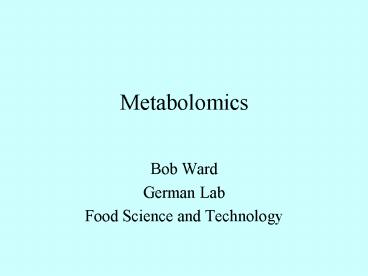Metabolomics - PowerPoint PPT Presentation
Title:
Metabolomics
Description:
Metabolomics Bob Ward German Lab Food Science and Technology – PowerPoint PPT presentation
Number of Views:183
Avg rating:3.0/5.0
Title: Metabolomics
1
Metabolomics
- Bob Ward
- German Lab
- Food Science and Technology
2
Genome- .All the DNA Transcriptome- .All the
mRNA Proteome- .All the proteins Metabalome .All
the metabolites
Metabolomics is a post genomic technology which
seeks to provide a comprehensive profile to all
the metabolites present in a biological sample.
(Taylor et. al, 2002)
3
Limitations of ohmics technologies
- Genomics
- Static picture Expensive Not for
individuals - Transcriptomics
- Need Genome (annotations) Correlated with
proteome? Sampling issues splicing
No info on modifications - Proteomics
- Technologically challenging Need genome?
4
Metabolome
- Same metabolites for all organisms
- 1k for organism vs 10k(genes) or 100k(proteins)
- Technology exists and is not too expensive
- Carbohydrate and Lipid info
5
6
Goal Discrimination between related genotypes of
Arabidopsis
- between Co10 and C24 (parent strains)
- between Co10 x C24 and progeny (F1)
- between (Co10 x C24) and (C24 x Co10)
- -Maternal line donates both mitochondria and
chloroplast - -Clear-cut realization of effectiveness
- -Potential to uncover biologically relevant info
7
Instrumental and Informatic Tools
- GC/MS-Separation/identification of polar
metabolites in 1200 second run time - AMDIS deconvoluting software
- MassLab to choose target ions
- R for statistics
- WEKA (standard neural network approach)
- Euclidean distance
- Principal Component Analysis
8
Data Work-Up
- Selection of reference chromatogram (F1)
- 8 individual samples for each genotype
- no replicates
- Selection of target peaks/analytes (433)
- normalized (mg analyte/wt sample)to internal
standard (ribitol) - Allows for simple 2-D matrix
9
- 201 metabolites identified in some detail
- (92 as molecular type and 109 by chemical
property) - High variance in low numbers corresponds to core
metabolites
10
Co10 1-8 C24 9-16 Co10 x C24 17-24 C24 x
Co10 25-32
11
Neural Network Analysis
P0.27
Lack of samples precluded use of a training
subset Leave one out cross used for
training Model judged by ability to classify
remaining object (repeated for all
objects) Allows for maximal use of data for
validation when n is low
12
Clustering by Euclidean distance
Co10 1-8 C24 9-16 Co10 x C24 17-24 C24 x
Co10 25-32
13
Principal Component Analysis
- Used to tease out role of individual metabolites
in discrimination - Unsupervised multivariate analysis applied to
functions of many attributes - Transformation of large set of related values to
smaller set of uncorrelated variables - Attempts to express maximum variance in data
- PCs are axes in multidimensional space
- Object characterized by distance to axis
14
Variance of data explained by first few principal
components
PCA algorithm from MatLab 78 of variation of
data from first 3 PCs
15
Principal Component Analysis
Co10 and C24 differentiated except outlier F1
genotypes cluster together
16
Contribution of each variable to first PC
Malate and Citrate- metabolites of TCA cycle
17
Relative peak area for metabolites malate and
citrate
Co10 contains outlier..may explain
misclassification
18
Other significant results
- Parental genotype removed from PCA analysis and
F1s discriminated by glucose and fructose - Inference that the first PC differentiates
parental line, and 2nd and 3rd differentiate F1 - Malate and Citrate from TCA, glucose and fructose
from chloroplasts
19
Conclusions
- Advances in technology will improve detection
limits and will allow characterization of
metabolites - Formalized ontology needed to link chemical
structure with pathways - Metabolite profiling is an exciting new field
which complements other non-hypothesis driven
global analysis technologies - Large amounts of informatic support to develop
field and to correlate data from genomics,
microarrays, and proteomics































